
Kimchi Jjigae is a classic Korean soup made from boiling fermented kimchi. It’s spicy, savory, and has a nice kick but brings ultimate comfort!
Did you know that Kimchi jjigae, despite being one of the most well-known soups in Korean cuisine, this is one of the rarest things Koreans order in a restaurant?
The main reason is that most Koreans have their own way of making kimchi and in the same way, they have their very own way of making kimchi jjigae.
This stew will differ in every Korean home but they’re all equally good. Everyone basically claims their mom’s recipe is the best! Kakaka~
For this recipe, I collaborated with my good friend Jessica in making a simple tofu kimchi jjigae. Here, we will teach you the most basic way of cooking it as well as tips and tricks I have to make it extra. Then, you’ll be able to customize the soup to your preference.
Jessica is a supermom, fellow Korean-American content creator, and good friend. I was one of the first creators she collaborated with where we cooked lunch for her children. Three years later, she’s out here hustling, making stronger content than ever, and I am now a father. Things have changed but we’re back at it, still sharing good old Korean recipes. Let’s go!
Ingredients You’ll Need
Disclaimer: I get a small commission at no additional cost to you when you make a qualified purchase under the affiliate links.
As mentioned, everything indicated here is simply the basics. Once you know how to make it with these ingredients, you’ll be able to customize the dish to your liking.
Fermented Kimchi
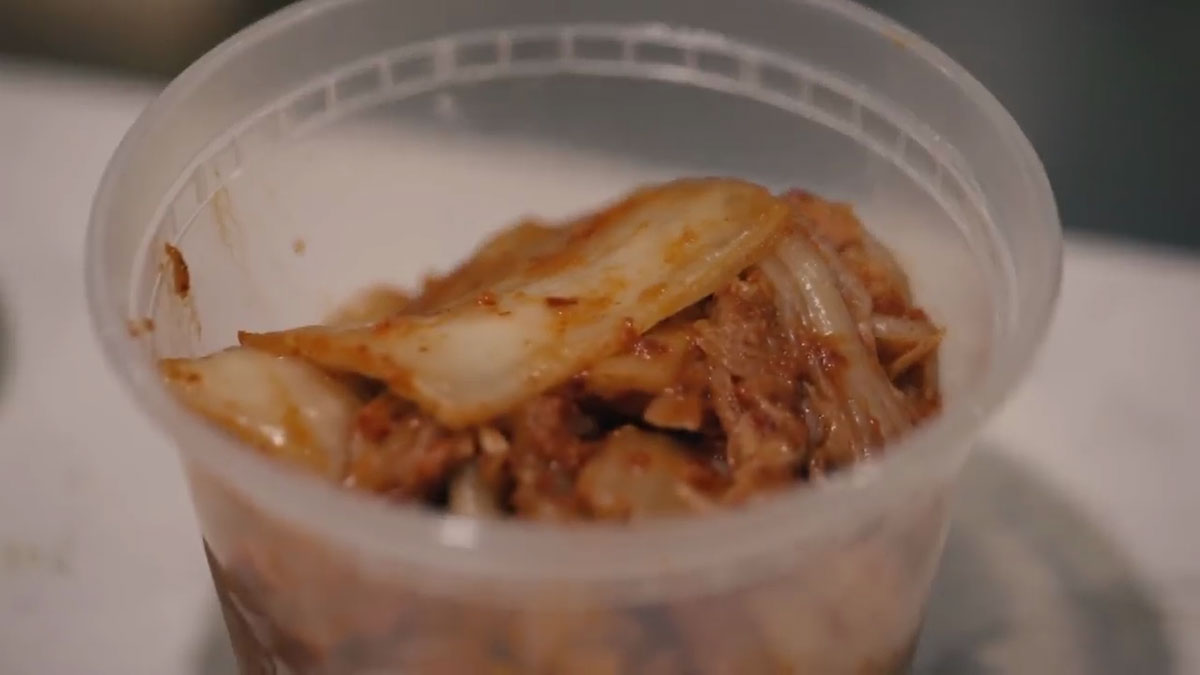
The best type of kimchi to use in this stew is the extra fermented kimchi—ones that have become too spicy and sour for that extra kick in the soup. Personally, boiling this for an extended period hits differently.
After kimchi making season (or gimjang), with the amount and variants of kimchi, we make—it becomes inevitable that we leave some stored and unused for several months. These are the ones we usually use to make other dishes like this soup, kimchi fried rice, or kimchi pancake because it’s now too aged to eat as is.
I don’t recommend using geotjeori (fresh kimchi) for this, instead find store-bought or restaurant-bought ones where you can really taste the sourness. If you know how to make one or you have a Korean friend who can give you this, then all the better!
Choice of Protein
Depending on your diet and your preference, you can make Pork Kimchi Jjigae, Tuna Kimchi Jjigae, or Mackerel Kimchi Jjigae. Usually, it would be a protein plus tofu, but if you’re vegetarian or vegan, you can opt out and simply use tofu. Just like this recipe!
Aromatics
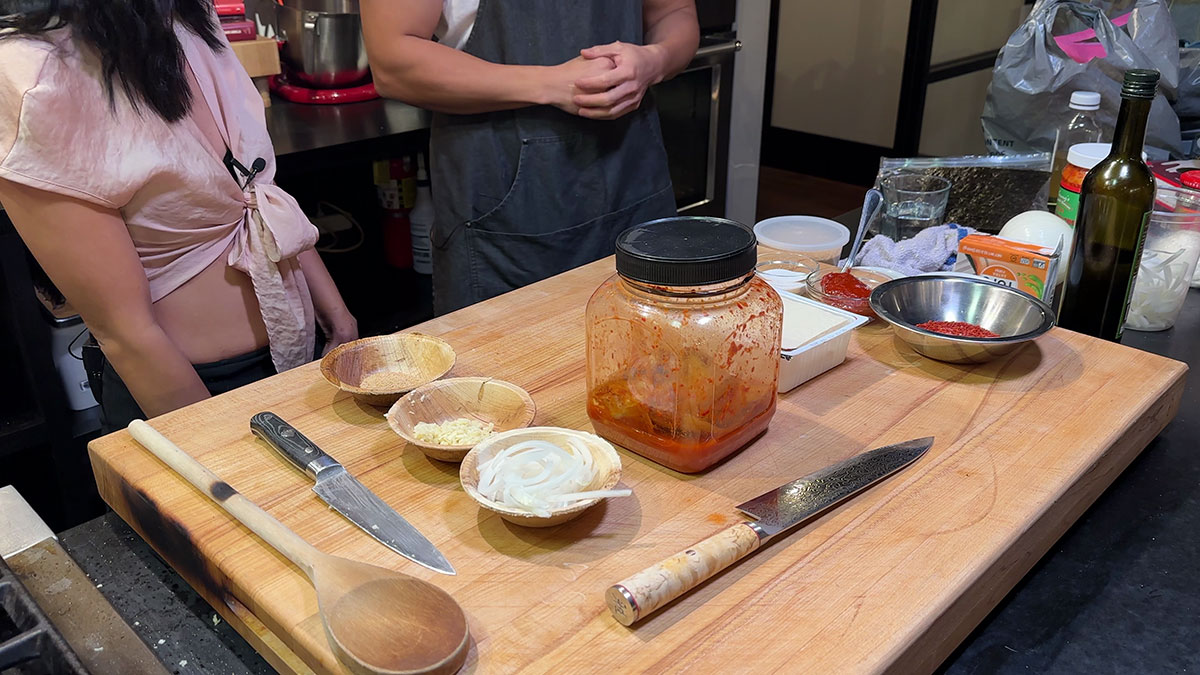
For the aromatics, it’s very basic. Garlic and onions are the way to go, and scallions are optional. You can use the onion and scallion to saute and make an aromatic soup base and garnish for an extra crunch to the soup.
Water or Broth
For the broth, you actually have a lot of options here. They may yield different depths of flavor, but they will all be definitely equally good.
- Water: This is the most basic soup base. While you may think it would lack flavor simply using water, the trick is to just adjust the seasonings until you reach your desired taste. More on seasonings later on.
- Rice Water: Back then, Koreans would typically use rice water in soups and stews because it adds flavor and thickness to the soup. To make this, wash the rice two times, and then use the third wash as the base of the soup.
- Beef Broth or Anchovy Broth: Using either of these broths will bring more depth and make the soup even more flavorful. Beef broth is what we use in the restaurant!
Seasoning
- Sugar – Since the fermented kimchi is spicy and sour, we will be using sugar to balance this out. This is the perfect complement for the fermented cabbage.
- Gochugaru – This is Korean red pepper flakes. Regardless if you use the coarse or fine grind, both work to add extra heat to the dish.
- Gochujang – This is Korean red pepper paste. Jessica likes adding gochujang for extra spice and savor to the soup. Alternatively, I like adding a little bit of soybean paste to make the soup richer without adding extra spice. You can use either of these!
- Dashida – This is the Korean version of bullion powder which comes in beef or anchovy flavor. You can use either and this will be extremely useful especially if you use water as your soup base.
- Black Pepper – I like seasoning my kimchi stew with a little bit of black pepper for contrast of flavor.
- Kimchi Juice – This is one of the most important ingredients to intensify the kick of the kimchi. A little bit of kimchi juice will go a long way! Alternatively, if you find that your kimchi lacks the sourness, you can add a little bit of rice vinegar.
TIP #1: You may notice that we don’t use salt in seasoning kimchi jjigae. This is because the gochujang and dashida are flavorful enough. if you find that it’s still a little bland, you can gradually add more of these or use soy sauce or fish sauce to season your stew.
TIP #2: To finish the soup, sprinkle in some sesame oil for extra flavor. It complements the dish really well!
How to make Kimchi Jjigae?
There are actually two ways to cook this Korean kimchi stew.
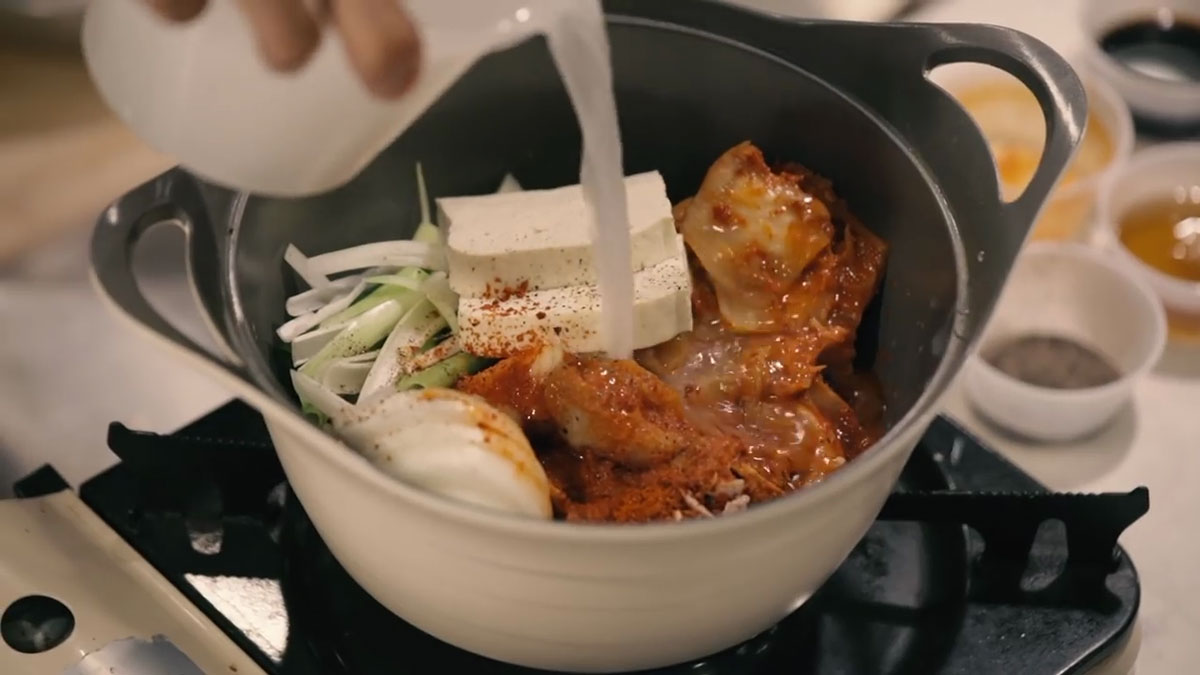
One, for an easy kimchi stew, you can place all the ingredients, seasonings, and broth in a pot and let it boil for 15-25 minutes.
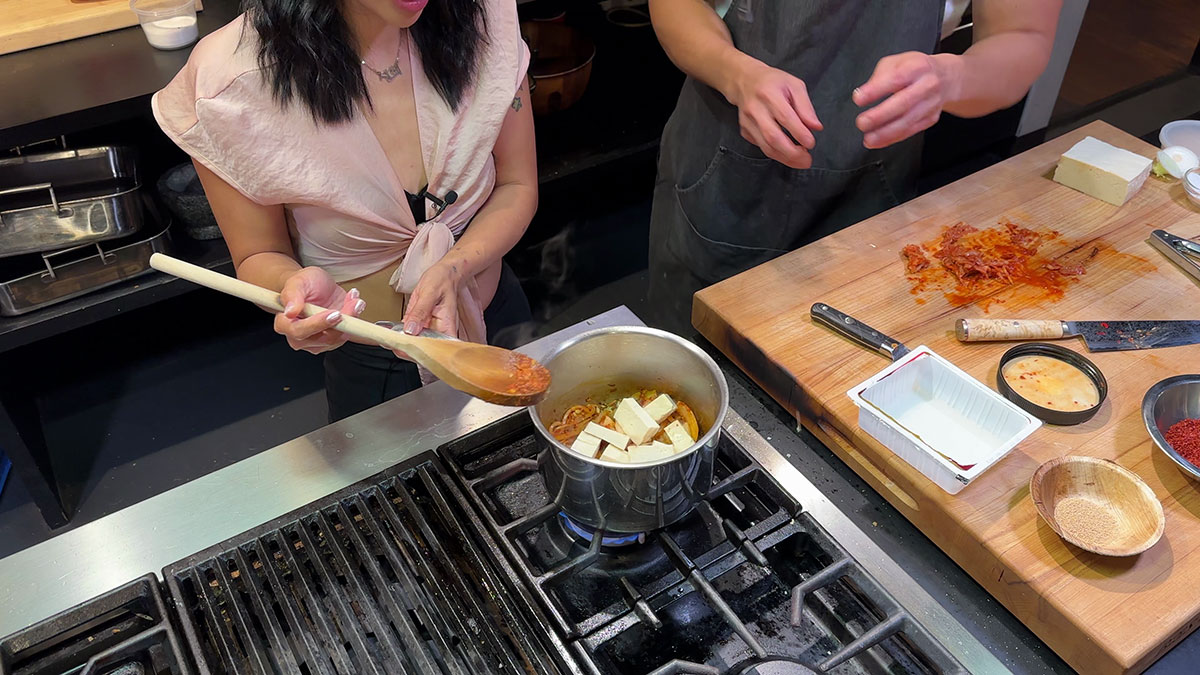
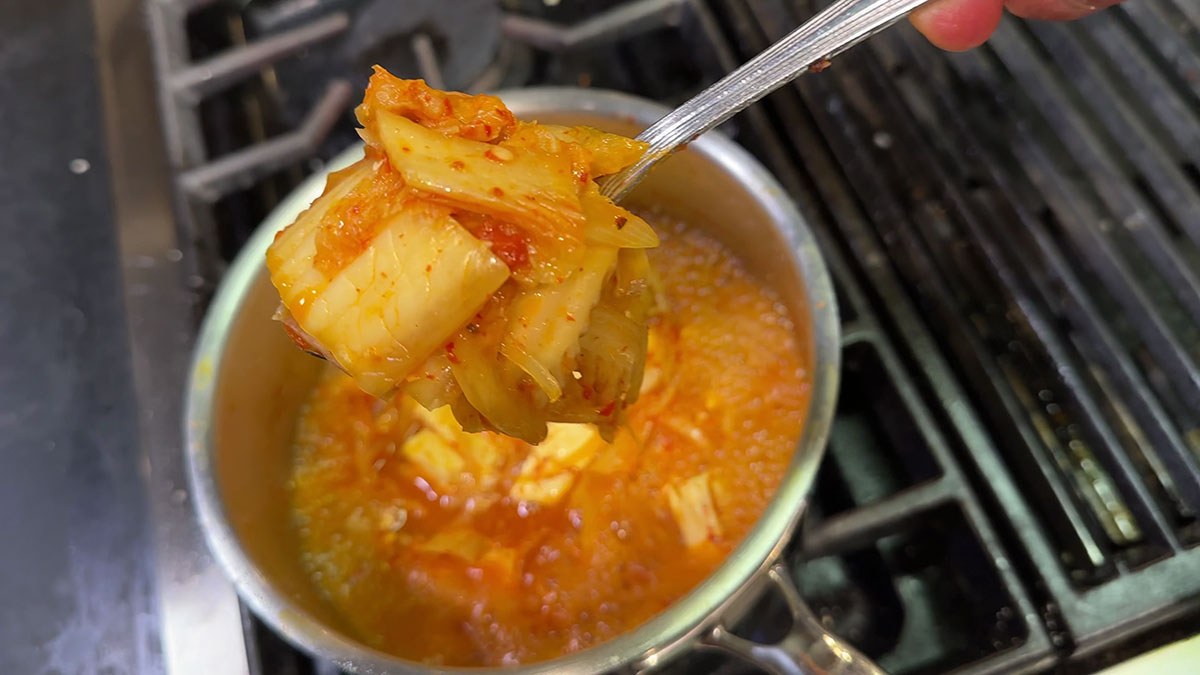
Another way is to first saute the aromatics, kimchi, and choice of protein, then add your soup base and season it to your liking, then boil it for 15-25 minutes.
Either way of making your kimchi stew works just as well. What matters is that you boil it for an extended period which will help all the flavors to be extracted and incorporated. So good!
How to serve Kimchi Jjigae?
When we cook single-serve kimchi jjigae, we like to make it in a ttukbaegi or stone bowl. This keeps the soup boiling and hot even after taking it off the fire. We simply like fresh and hot hot hot!
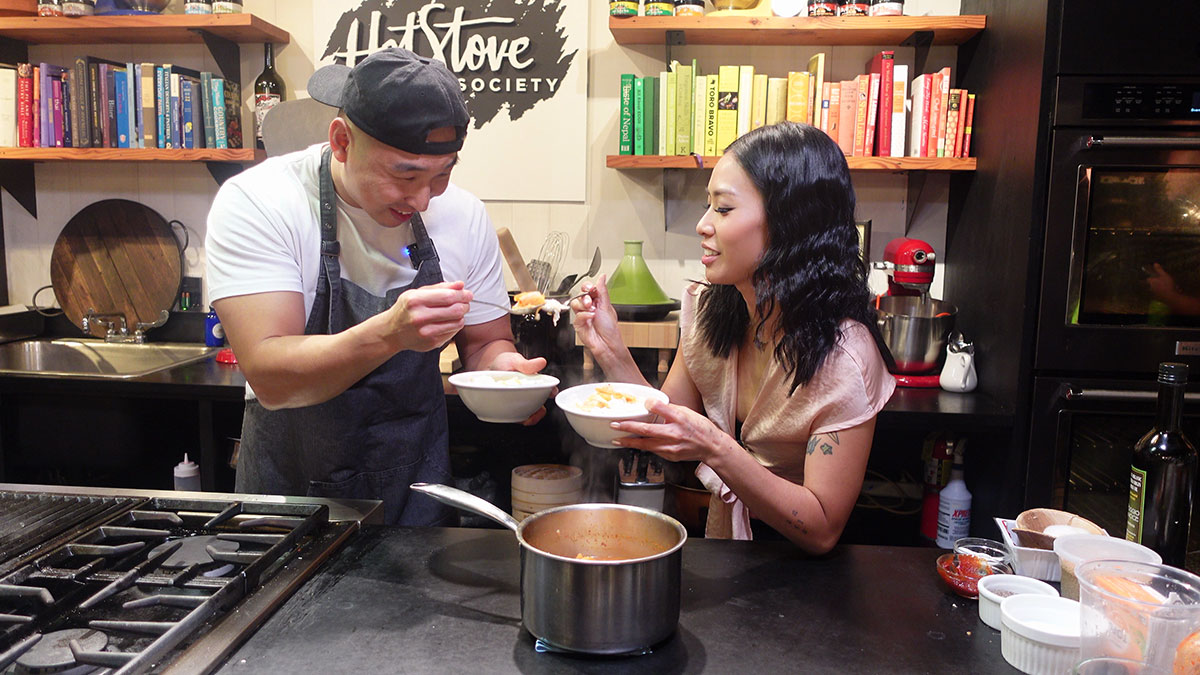
You can also cook this in a pot for bigger groups and you bring the pot in the middle of the table so it can be eaten communally.
If you make a really good kimchi stew, the only thing you’ll need is freshly steamed rice. Hands down. But you can also eat this with other side dishes like beansprout salad, scallion kimchi, sweet potatoes, stir-fried fishcake, or crabcakes.
How to store Kimchi Jjigae?
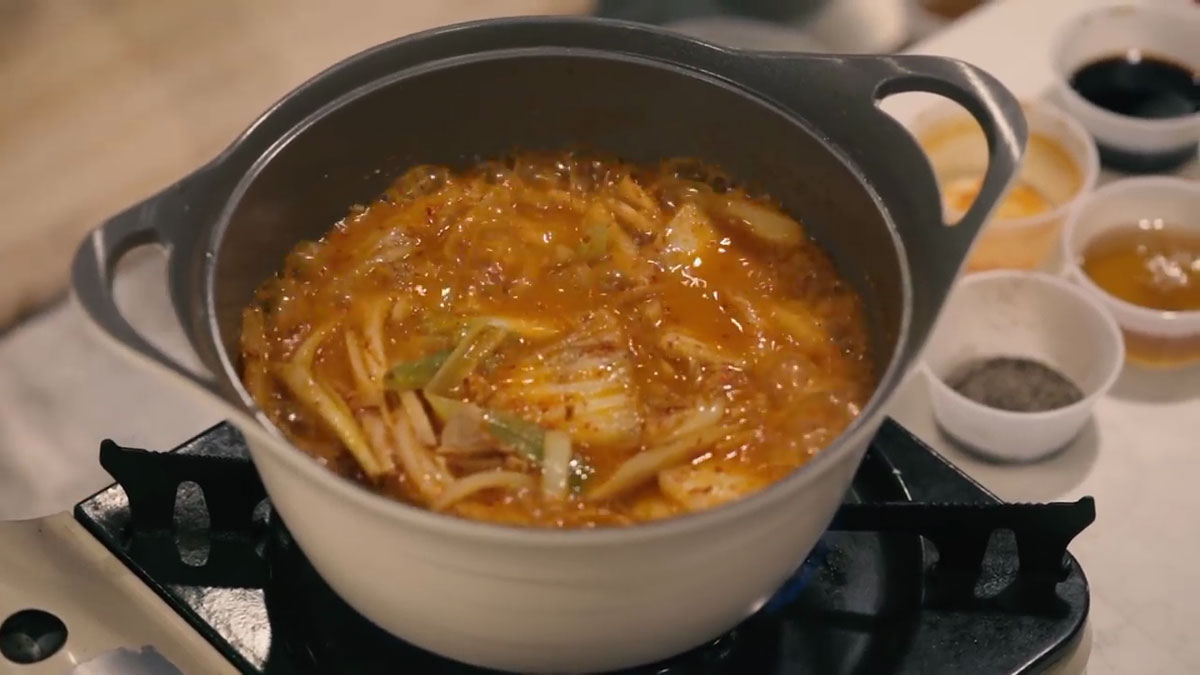
When I was young, my mom would usually make a big batch of the stew and just leave it for me and my sister to eat all day. I loved reheating it because it just tasted better and better each time.
Any leftovers can last in the fridge for several days and then be reheated in the microwave or in the stove. If you find that the kimchi, protein, or soup are running out, you can simply continue adding them and cooking the soup again.
Other Korean soups and stews you might like:
Make sure to leave a rating, a comment, or tag me on Facebook, Instagram, or Tiktok when you chop them up! Yeobosayo!
Kimchi Jjigae (Korean Kimchi Stew)
Equipment
- Ttukbaegi
Ingredients
- 1 tbsp Oil
- 1 tbsp Minced Garlic
- 1/4 of Large Onion Julienne
- 1 cup Kimchi Chopped
- 1/3 tbsp Sugar
- 1-1.5 tbsp Gochugaru
- 70 grams Firm Tofu Sliced to you desired size
- 2-3 cups Water
- .5 to 1 tbsp Gochujang
- 1 tsp Beef Dashida
- Black Pepper To taste
- 1/4 cup Kimchi Juice
Instructions
- In high heat and with a little oil in the pot, saute the garlic, onion, and kimchi then season with sugar and gochugaru. Mix really well.
- Add the firm tofu or any protein of choice, and saute until 80% done.
- Add water or soup base of choice then season with gochujang and dashida. Mix really well.
- Allow the stew to boil for 15 minutes, then taste and adjust until it reaches your desired taste.
- Note: If it’s too sour, add sugar. If it lacks kick, add kimchi juice or rice vinegar. If if lacks the depth of flavor, add gochujang, soybean paste, dashida, soy sauce, OR fish sauce. Choose only one!
- Once the desired taste is reached, allow it to boil for a few more minutes.
- Serve hot with freshly steamed rice and some banchan. Enjoy!
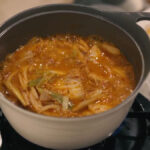

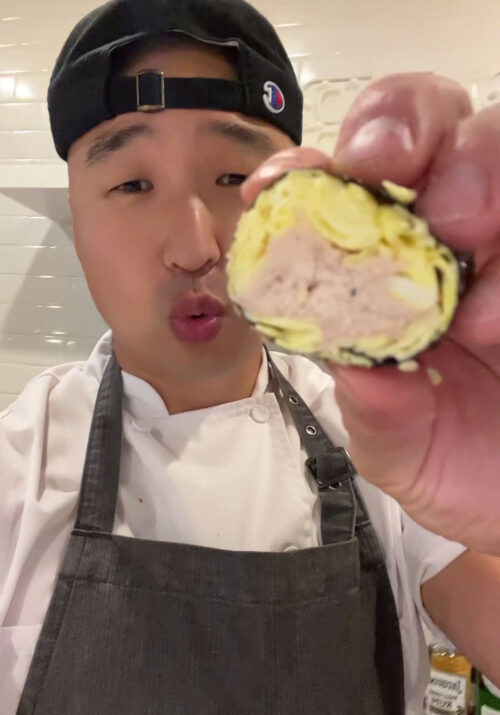



Ummmm.. This was the first recipe I’ve tried of Chris’ and this was really a dish my mom used to make me growing up and it came out exactly as I remembered it as a kid! Your recipe is great and I loved how it comes together so quickly and was a perfect meal to just throw together with whatever leftovers you have on hand too like you can always add some mushrooms or veggies in it. I cooked up a little spam and then added it in when I added the tofu and cracked an egg right before serving too.
Wow, thank you so much for sharing this. I’m so so happy it turned out just like how your mom cooked it.